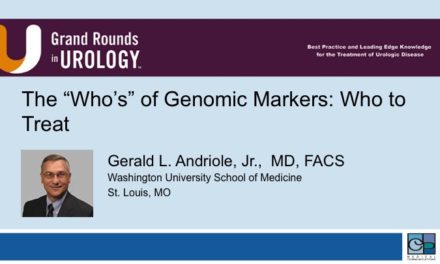Dr. Alan W. Partin presented “Non-genomic Biomarkers for Early Diagnosis and Prognosis Prevention of Prostate Cancer” at the 27th annual International Prostate Cancer Update meeting on Wednesday, January 25, 2017.
Keywords: prostate cancer, non-genomic biomarkers, exosomes, PCA, prostate health index (phi), ConfirmDx, Exo 106
How to cite: Partin, Alan W. “Non-genomic Biomarkers for Early Diagnosis and Prognosis Prevention of Prostate Cancer” January 25, 2017. Accessed Dec 2024. https://dev.grandroundsinurology.com/non-genomic-biomarkers-prognosis-prevention
Transcript
Non-genomic Biomarkers for Early Diagnosis and Prognosis Prevention of Prostate Cancer
Today I’m going to talk about Phi, PCA3, ConfirmMDx, and one we haven’t talked about, Exo106, the exosome test. There’s been a lot of, especially if you went to breakfast this morning, redundancy on a lot of things test, and to save time for the panel I’m going to move through them fairly quickly, and maybe just focus a little bit on the science of them as opposed to the data that’s already been shown.
By way of disclosure, I’ve been an investigator for all these companies.
I’m not going to talk about these other biomarkers, not because they’re not important, actually I’m seeing them quite often in my clinic now, there’s just not enough time. 4Kscore has been fabulous. My patients are bringing it in. We don’t actually have the access to run it at Hopkins, but I’ve seen a lot of it. The other tests that Gerry just talked about, we have that magical mystical pathologist that can do be PTEN at Hopkins so we do quite a bit of that, and maybe we’ll have a question about that at the panel. So the only reason I’m not talking about these is because I only have 20 minutes.
The first test was Phi, and it was FDA approved in 2012. This was a paper a large group of us worked together on to get the data together to send it to the FDA. And as you know, Phi is what’s called a complex mathematical equation.
But this is what happens with Phi. And we use it on every patient we see now. I tend to believe in our 1.5 paper that we put out, that we need another test when the patient comes in. We try not to use it for PSAs above 10, but everyone that comes in gets a Phi test for initial and repeat biopsy so that we can try to determine whether or not the biopsy is actually needed. This was a paper out of Italy just before, actually just after FDA approval, that showed they were able to decrease, and that would be the specificity, when they added Phi to multivariable model, the number of unnecessary biopsies by 41%. So Phi is better than PSA alone. And this was just in detecting prostate cancer.
Here’s a nice paper by Stacy Loeb in the Journal of Urology, where she used area under the curve, and the blue line is the Phi, to try to predict all cancers. The second graph was to try to predict the Epstein significant cancers, and the last one was cancers with a greater than or equal to 7 Gleason score. And you can see in that large study the Phi was the superior marker.
Here was a small study done by Ashley Ross and our group at Hopkins, published in Urology just last April, where we looked at its ability to help predict high-grade cancer in African-American men. And with this cohort, Phi was an excellent marker in trying to also help predict high-grade cancers.
Now finally, the next test, PCA3, we’ve heard a lot about this morning and today. It is an excellent urine test for trying to predict whether you have prostate cancer. It’s really not that much better than just doing PSA alone. It does require that horrible vigorous digital rectal exam that patients hate. It’s sort of disappearing, I agree with David. This company went head-long into trying to couple PCA3 with TMPRSS2 and for some reason just sort of dropped off the face of the Earth. So I do still see a few patients coming through that are having this test done, but it’s not as popular as it had been. And I’m just going to go through this quickly.
We did a really nice study no on showed this morning on PCA3. John Wei led a group of us from the National Cancer Institutes Early Detection Research Network. A fairly large study, and we broke the test down into its positive predictive value use, and its negative predictive value use. So if you want to use it on initial biopsy and you want really high positive predictive value, because you don’t want to miss cancers, if the score is greater than 60, and for those of you that have used it that’s not that common, but it does happen, it has a positive predictive value of nearly 90%, or 80%; sorry. However, if you have a patient coming back for a repeat biopsy a score of less than 20, which is pretty low, would give you a negative predictive value of 88%.
We’ve heard a lot about these Epi genetic tests. What they’re talking about with this methylation is simply placing a methyl group usually in the promotor area of a gene to shut that gene down. It doesn’t mutate it, it doesn’t delete it, it doesn’t make you have multiple copies of it, it just stops it. This is a very sensitive test that we’re using. You can find it in paraffin. That’s why we were able to do retrospective studies on it. And you can detect a cancer cell among 10,000 normal cells with this test, so it’s very specific.
We talked about this paradigm that every year we’re biopsying a little over a million men, but only about a quarter of them were found to have cancer. Leaving three-quarters of those, or about 750,000 men walking around with a negative biopsy but still having a PSA of 6.4 and not knowing what to do. And a lot of men also had, as Scott showed us, high-grade PIN and atypia. And that’s where as we’ve seen in these pictures, there is a halo effect around these tumors and you can detect in a negative biopsy core that there’s something going on in that area. We talked about this algorithm in Dr. Crawford’s talk, that if the ConfirmMDx test is positive you might want to consider something else, get that MRI, or do some kind of mapping biopsy in that area. Scott very eloquently went over the MATLOC study, the DOCUMENT study, and we saw that the negative predictive value of this test is excellent, approaching 90 in MATLOC, and 88 in the DOCUMENT study. Scott also showed these slides about the odds ratio being great for the Epigenetic test in an initial. This was the study on the repeat biopsy. And here’s some data, I’m not sure if Scott showed this, but you can use this test to clinically detect significant cancer, because if the algorithm that they’re using for this Epic score, get right to that, it has an odds ratio of 16 for detecting Gleason score greater than 7, which is now, again, this is looking for aggressive cancer, not whether you have cancer, far greater than atypia or the other high-grade PIN, age, et cetera.
Now, this last test is called Exosome 106. This was presented in, or published in The Journal of the American Medical Association (JAMA) Oncology in March of 2016. It was presented at the American Urological Association (AUA) in 2015 by Jim McKiernan. Again, we had a pretty large group, Gerry, in the audience, was on the study, where we were taking a look at urine specimens to collect these exosomes. Exosomes are kind of like Twitter, since our President does it so much. The exosomes are sending out Tweets and getting Tweets back to the cells, talking back and forth between the microenvironment in these cells. So they collect up a bunch of information, and just like the President, just spit it out into the area around the cell. And the other cells pick it up and try to figure out what’s going on in that cell. And likewise, they can suck up information from the cells surrounding them and talk to each other. These exosomes are—and I have a great slide I didn’t put it in here that I use for the patient groups, showing the little Twitter phone doing that. They put a lot of information in these little bubbles. There’s RNA, protein, DNA, and hopefully some new markers that we weren’t even aware of. So in this study you just collect a sample of urine. They like you to get a clean catch. This company now has a special cup that collects only the first 20 ccs, it seals the cup off so the rest can be discarded. No DRE is needed. Right now they’re looking at three genes, two of them are oncogenes. The other is the PCA3 RNA that we talked about before. And in a multivariable algorithm the probability of high-grade cancer being present in the prostate carries with it an excellent ROC. And if you take it to the negative predictive value it’s 91%. So that’s a fresh catch urine, no DRE, and they’re able to, again, provide us a negative predictive value of 91%.
So in conclusion, the exosome will messenger RNAs for those oncogenes and PCA3 can be analyzed on a first catch random urine. We talked about which tests we’re doing. It has an excellent negative predictive value. And this test is now available through CLIA lab testing.
And I put this slide together. It matches some of what Dr. Crawford showed us. Most of these tests are now available. I get that question from a lot of crowds, is this is just something I can get at Wash U or in Colorado. No, if you’re willing to go out there and talk to the representatives you can get all these tests. The costs are variable. There’s major differences between some of them. I find now that a lot of them have programs to try to help our patients get these tests so that they don’t have to sell their car. It’s working out very well. And of these tests, expect for PCA3, we’re not really having any problem getting them done. Thank you.
ABOUT THE AUTHOR
Dr. Partin is the Jakurski Family Director and Professor of Urology at Johns Hopkins in Baltimore, Maryland. He is the author or co-author of more than 500 scientific articles, serves on numerous editorial boards, and is Editor-in-Chief of Urology Case Reports and editor of the Campbell-Walsh urology text. He has been honored with many awards, including the Hopkins Young Investigators Award, the Pfizer Scholars in Urology Award in 1996, and the “Gold-Cystoscope” award in 2001. In 2004, Dr. Partin was named Director of the Department of Urology at the James Buchanan Brady Urological Institute and Urologist-in-Chief of Johns Hopkins Hospital.
Dr. Partin is an expert in assessing prognosis and making predictions for men with prostate cancer. The creation of The Partin Tables, which can predict with 95 percent accuracy a man’s likelihood of being cured by treatment, made his research famous. Dr. Partin’s laboratories focus on developing and testing new and existing methods for predicting the aggressiveness of prostate cancers so that rational treatment decisions can be made by both patients and physicians.
Dr. Partin’s laboratories have investigated many new “PSA-like” serum tests, some of which are soon to become available for the diagnosis of prostate cancer as well as basic science investigation of new proteins—which may help in detection—and staging of prostate cancer. In addition, Dr. Partin has an academic and clinical interest in the treatment of benign prostatic hyperplasia with an emphasis on minimally invasive techniques.
Dr. Partin received his undergraduate degree in Chemistry from the University of Mississippi, where he was an Academic All-American football player. He received his medical degree and his PhD in Pharmacology and Molecular Sciences from Johns Hopkins University, where he continued his postdoctoral training.





